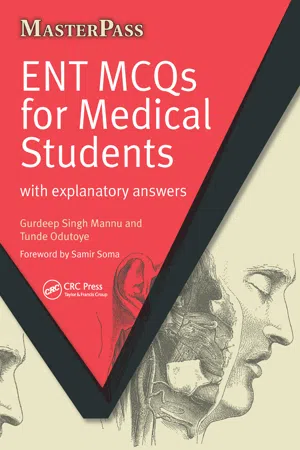![]()
The ear
Questions
1. With regard to Ménière’s disease, the following statements are true:
a It typically presents between the ages of 30 and 50 years.
b It is characterised by the triad of hyperacusis, vertigo and tinnitus.
c Treatment involves lifestyle changes such as a low-salt diet and the medical addition of a thiazide diuretic.
d Audiometry will show a conductive hearing loss.
e It can cause drop attacks.
2. Causes of dizziness include the following:
a Ménière’s disease.
b Acute otitis media.
c Cardiac arrhythmia.
d Long-standing poorly controlled diabetes.
e Migraine.
3. With regard to labyrinthitis, the following statements are true:
a It can be a complication of upper respiratory tract infections.
b It may cause hearing loss.
c There is nystagmus towards the affected ear.
d Vestibular suppressants are used in treatment.
e It may be caused by viruses or bacteria.
4. With regard to vestibular neuronitis, the following statements are true:
a Like labyrinthitis, vestibular neuronitis follows an upper respiratory tract infection.
b It affects women more often than men.
c If left untreated, it may go on to cause permanent deafness.
d On examination, nystagmus may be elicited towards the affected ear.
e Antiviral drugs are the mainstay of treatment.
5. With regard to Ramsay Hunt syndrome, the following statements are true:
a It may present with facial palsy, hearing loss and vertigo.
b It can be differentiated from Bell’s palsy by the presence of cutaneous vesicles in the ear canal.
c It is caused by adenovirus.
d It may be treated with acyclovir and prednisolone.
e It has an excellent prognosis, and 99% of patients regain pre-morbid facial nerve function.
6. With regard to benign paroxysmal positional vertigo (BPPV), the following statements are true:
a It may present with severe vertigo when facing a certain direction.
b Symptoms may be elicited by the Dix–Hallpike manoeuvre.
c It is caused by the presence of an otolith moving within the semi-circular canals.
d It may be treated by the Epley manoeuvre.
e BPPV originating from the horizontal and posterior semicircular canals can be differentiated by inspection of the respective type of nystagmus.
7. With regard to acoustic neuroma, the following statements are true:
a It is a vestibular nerve Schwann cell neoplasm.
b It is a fast-growing and deadly cancer if missed.
c It may present with hearing loss and vertigo.
d It is usually treated by chemotherapy.
e It has an incidence of less than 1 in 100 000.
8. The following drugs are known to be ototoxic:
a Gentamicin.
b Some chemotherapy drugs.
c Cimetidine.
d Aspirin.
e Quinine.
9. The causes of conductive hearing loss include the following:
a Cholesteatoma.
b Acoustic neuroma.
c Presbycusis.
d Otosclerosis.
e Benign paroxysmal positional vertigo (BPPV).
10. Treatments for excess cerumen (ear wax) include the following:
a Regular use of a cotton bud to ensure deep cleaning.
b Irrigation.
c The use of cerumenolytic agents.
d Direct visual removal of cerumen using an otomicroscope.
e Blind removal in primary care.
11. An HIV-positive patient presents with deep boring ear pain and a red inflamed ear canal and pinna. The following statements are true:
a This is most likely to be a case of necrotising otitis externa.
b The most likely cause is the pathogen Pseudomonas aeruginosa.
c This should be treated conservatively with rest and topical hygiene.
d Mortality of untreated cases may be one in every five patients.
e This condition may cause a facial nerve palsy.
12. With regard to cochlear implants, the following statements are true:
a The human ear is capable of detecting sound within the frequency range 20–20 000 Hz.
b The implants work by amplifying sound.
c Cochlear implants are used in patients who are suffering from mild to moderate sensorineural hearing loss.
d Patients who receive cochlear implants are at a higher risk of meningitis.
e The majority of profound deafness is congenital in nature.
13. With regard to presbycusis, the following statements are true:
a It has a higher prevalence in people of Afro-Caribbean origin.
b It presents as unilateral sensorineural hearing loss, starting with high-frequency sound.
c It may be treated with a hearing aid.
d A patient with this condition will present with a reduced ability to differentiate consonants rather than vowels.
e The aetiology of this condition is thought to be due to the degeneration of the tiny hair cells in the cochlea.
14. Causes of tinnitus include the following:
a Furosemide.
b Exposure to loud noise.
c Benign paroxysmal positional vertigo.
d Ménière’s disease.
e Multiple sclerosis.
15. With regard to autoimmune hearing loss, the following statements are true:
a It presents as a gradual bilateral sensorineural hearing loss.
b The condition improves with the use of steroids.
c It may present with fluctuating sensorineural hearing loss, tinnitus and vertigo.
d It is more common in men.
e Immunosuppressants may be helpful.
16. With regard to mastoiditis, the following statements are true:
a It can develop as a complication of otitis media.
b If left untreated, mastoiditis can result in meningitis and facial nerve palsy.
c Antibiotics are the mainstay of treatment.
d Myringotomy should be avoided, due to the risk of further infection.
e Mastoiditis is an indication for mastoidectomy.
17. With regard to cholesteatoma, the following statements are true:
a It can be caused by squamous epithelium that is abnormally confined in the temporal or mastoid bone.
b Replication of squamous epithelium causes destruction of its containing bone.
c It may result in meningitis and brain abscess.
d It usually presents with a painful discharge from the ear along with hearing loss.
e Treatment is with systemic antibiotics.
18. With regard to otosclerosis, the following statements are true:
a It has no ethnic predominance.
b It results in a sensorineural hearing loss.
...